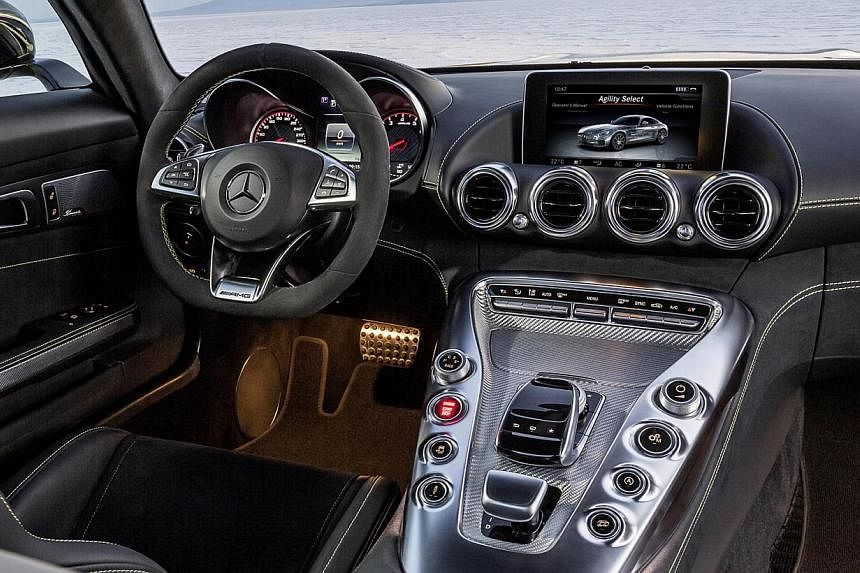The laws of aerodynamics have not changed since they were first quantified nearly 300 years ago. But for sports car manufacturers, the interpretation of the laws can differ.
So even though the new Mercedes AMG-GT has a rear section that has an uncanny resemblance to a fellow German company's iconic numerically identifiable model, there are subtle variations to the theme, not all of them good.
For instance, from the back, the way the lower section of its tail perks up slightly reminds me of a certain model from an American brand once married to Daimler. The model is so dreadful my mind refuses to recall its name.
Fortunately, most other angles of the AMG-GT are pleasing to the eye. Its long, stout bonnet - replete with sporty air vents - is right out of the dramatic Mercedes SLS. As does its bold and unique grille. And its high door sills.
There are good reasons for that, of course. Like the SLS, the AMG-GT is a sports model developed from the ground up by AMG. And it uses a modified SLS platform. But beyond that, it is not the same car, and all the better.
The wheelbase is substantially shorter, along with the overall length. But the width is the same as the SLS'.
The dimensions have made the AMG-GT more nimble, more controllable and more relevant to roads which are not straight for kilometres on end.
Aiding and abetting that is the relatively light weight of the car and how that weight is distributed. Its twin turbochargers sit just above the V8's cylinder banks, allowing the power plant to be placed just behind the front axle.
This gives the AMG-GT a front-rear weight distribution of 47:53, which is the same as the SLS. But because the car is not as long but just as wide, it is more planted, more dynamic.
The proof of the pudding comes in the form of a 250km test route south of San Francisco, first along the Californian coast before turning into the giddying roads of the Santa Cruz mountain range.
Even though the tarmac is wet with a persistent rain, the long-nosed car - in the form of the higher grade AMG-GT S - feels quite at ease during most stretches of the journey.
The first noticeable thing is its ride quality. In its default Comfort mode, it is more cushy and pliant than the Porsche 911, a car that is within the AMG-GT's performance sphere.
In this mode, the AMG is a very obliging cruiser, promptly delivering healthy doses of acceleration even in seventh gear. Its V8 burble and exhaust note serve as background music as the car laps up distances almost nonchalantly.
Before you know it, the relatively straight coastal road gives way to some of the nastiest twists and turns in the civilised world.
If the wet does not make things bad enough, steep inclines and intermittent fog add to the confidence-sapping mix.
But the AMG-GT does not flinch, at least most of the time anyway. Its wide squat stance ensures it has a steady hold of the slippery serpentine slopes that make you think of AC/DC's Highway to Hell.
Its steering is among the best in the business. It is crisp, and weighty enough, with the effortlessness and adaptiveness that modern steering systems offer. Yet, it feels very natural in an almost old-school sort of way.
Combined with the linearity of its power delivery, the car is more than a shade of the politically incorrect but deliciously addictive big-bore AMG creations of the past.
The car is not without temper. Squeeze its throttle a little too hard or too quickly and its rear tyres lose traction. This is especially so in Sport+ mode, which is a notch below Race.
Race mode is best used at a private venue, for instance, the 3.6km Laguna Seca Raceway. It has 11 turns, including the infamous "Corkscrew", a pair of sharp bends interspersed with a sharp descent.
Alas, we are advised not to use Race mode, which turns off the car's stability control. We are also advised to keep the suspension setting in medium firmness, to allow for more grip, especially in the rear.
As it turns out, they are very good tips. On the track, where overall speeds are up to 50 per cent more than what public roads allow, the rear-wheel- powered car shod with fat tyres slip-slides at the slightest provocation. That is perhaps what you get with 650Nm of torque rushing to the rear axle from just 1,750rpm.
It is the same with stopping. The brakes are sensitive and they bite hard. At times, the rear breaks loose when the left pedal is applied too eagerly.
If not for the electronic nannies that bring the AMG-GT back in line, running off the tarmac or spinning out of control would have been a real possibility.
While it is tempting to say the AMG-GT S is a car reserved for only expert drivers, the truth is less sensational. That is, the German racer is something that should be treated with respect, especially in wet conditions.
And if you think about it, that goes for most cars. After all, the laws of physics have not changed.


